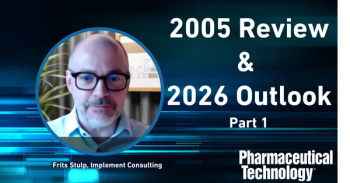
Capabilities and Limitations of Molecular Simulation for Formulation Development
As a pharmaceutical formulation tool, molecular simulation is currently in its early infancy. Nonetheless, presenters at Wednesday?s AAPS Annual Meeting and Exposition demonstrated that the technology is beginning to attract some interest. The topic was discussed in a presentation titled "Application of Molecular Simulations to Formulation Development and Stability Prediction."
As a pharmaceutical formulation tool, molecular simulation is currently in its early infancy. Nonetheless, presenters at Wednesday's AAPS Annual Meeting and Exposition demonstrated that the technology is beginning to attract some interest. The topic was discussed in a presentation titled "Application of Molecular Simulations to Formulation Development and Stability Prediction."
Bradley D. Anderson (University of Kentucky) provided an overview of molecular dynamics for studying drug stability in amorphous solids. Although formulators cannot predict stability in a formulation before synthesis, many currently available tools do allow qualitative inferences for formulations in solution. According to Anderson, the question formulators often ask is, Can knowledge based on solution behavior be applied to understand reactivity in amorphous solids? Because the molecular dynamics of the particles in the amorphous state are so different from those in solution (e.g., restricted mobility), answering this question becomes a complex issue.
To demonstrate the challenges of working with samples in the amorphous solid state, Anderson presented results of studies that, based on chemical observations, demonstrated the impact of molecular size on reaction properties. One such study, conducted by Park et al. (JACS, 123, 49-56 [2001]), showed significant differences in Arrhenius behavior between a solution and different polycarbonate powders even when there was only a two-fold difference in particle size, thereby demonstrating extreme sensitivity to particle size.
Further exploring the dependence of molecular dynamics on particle size, Anderson also presented results from a molecular dynamics simulation of a system consisting of six polyvinylpyrrolidone chains. Among other parameters, the study explored reactive mobility and heterogeneity. "The overall message is that we can understand a considerable amount of what is happening in the solid state by first understanding the pathways occurring in solution and then considering how increased immobility affects those various pathways," said Anderson.
Christopher Roberts, PhD (University of Delaware), began his presentation with a review of molecular simulation, especially as an aid to formulation. In a brief presentation of "science versus sales pitch," Roberts listed the real-world capabilities and limitations of the technology. For example, molecular simulation cannot be used to measure glass-transition temperature (Tg) directly, because it takes too long. The technology also has limitations in the size of particles it can be used on and the time needed to get meaningful data. Roberts concluded, "To properly use molecular simulation currently requires an experienced user - analogous to at least ten years ago with NMR, LCMS, and FTIR. This will change as the industry evolves, but we are not yet there."
Presenters at the symposium included:
Drug Stability in Amorphous Solids: Insights from Molecular Dynamics,
Bradley D. Anderson, PhD, HB Koste and the Department of Pharmaceutical Science, University of Kentucky
Molecular Simulations as an Aid in Rational Design of Lyophile Formulations,
Christopher J. Roberts, PhD, Department of Chemical Engineering, University of Delaware
Molecular Crystal Global Phase Diagrams: A Tool for Handling Polymorphism,
Richard B. McClurg, PhD, University of Minnesota
Molecular Dynamics and ab initio Calculations of Reaction Mechanisms of Drug Molecules,
Chang-Guo Zhan, PhD, University of Kentucky
Molecular Simulations Applied to Lipid-Based Formulations,
Colin Pouton, PhD, Monash University.
Newsletter
Get the essential updates shaping the future of pharma manufacturing and compliance—subscribe today to Pharmaceutical Technology and never miss a breakthrough.




